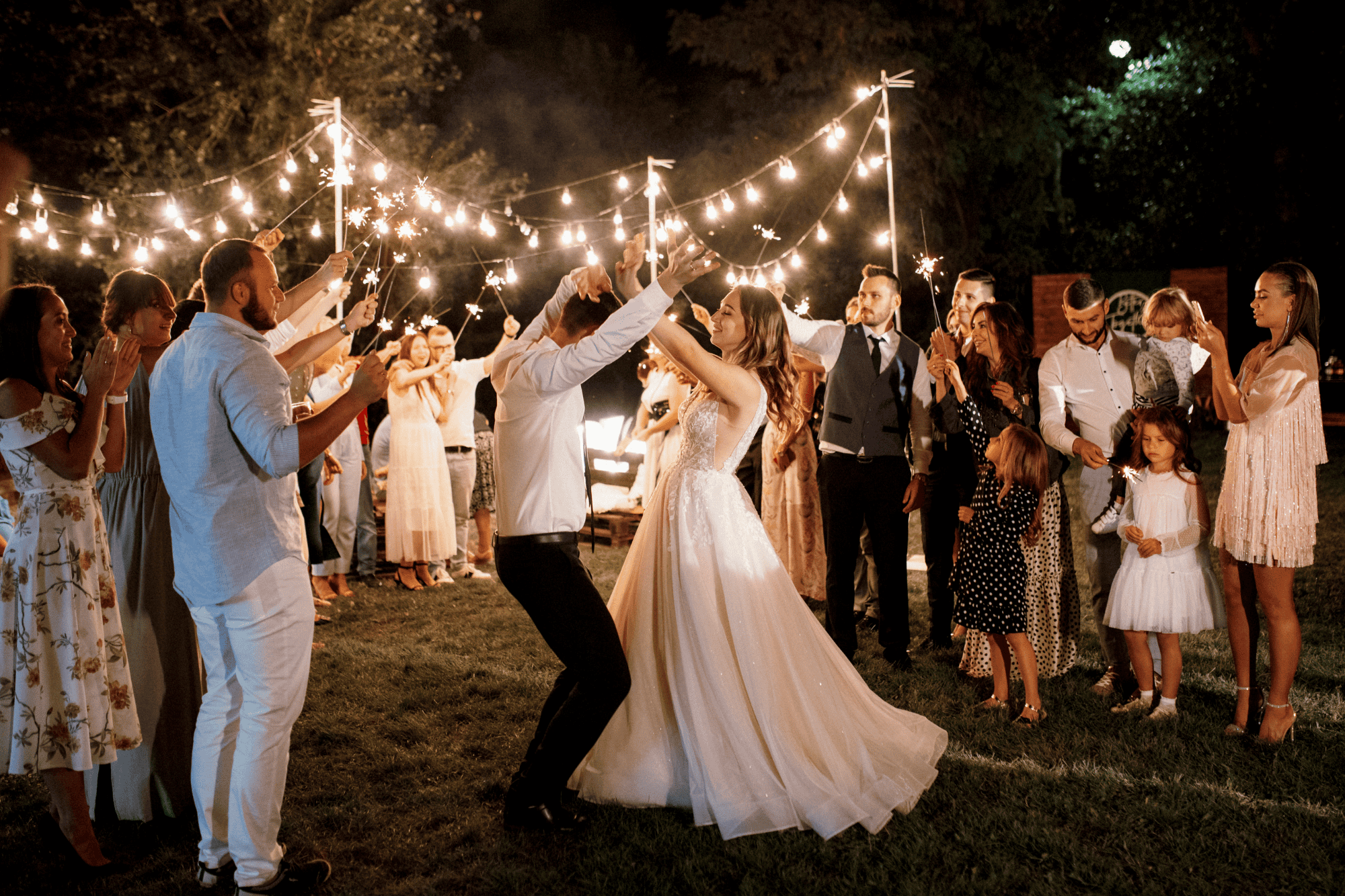Creating your wedding guest list can feel like a balancing act, as it involves deciding who to invite while considering budget, venue capacity, and family expectations.
It’s often one of the more challenging aspects of planning, but getting it right ensures that the most important people share your special day.
This guide walks you through the process, helping you prioritise guests, manage expectations, and set clear boundaries—ensuring the event stays within your means and reflects the relationships that matter most.
Let’s get straight to the point
Creating a wedding guest list involves balancing your budget, venue capacity, and relationships.
Start by drafting an initial list, then prioritise close family and friends. Set clear rules for plus-ones, and consider family expectations.
Limit work colleagues and decide whether to invite children. Use an “A” and “B” list strategy if needed. Communicate invitations early, and be prepared to adjust based on RSVPs.
Clear planning and communication help manage the process smoothly, ensuring your special day is shared with the people who matter most.
Tip To Determine Your Wedding Guest List
Creating a wedding guest list can be one of the most challenging parts of wedding planning. It involves balancing your budget, venue size, and personal relationships to ensure that you invite the right people. By following a step-by-step process, we can make this task more manageable.
Start With Your Budget And Venue Capacity
Before making any decisions about the guest list, it’s essential to determine your wedding budget. Your budget directly affects how many people you can invite, as catering, seating, and venue size depend on the number of guests.
Next, consider the capacity of your chosen venue. The venue may have restrictions even if your budget allows for a large guest list. We must ensure the number of guests fits comfortably within the venue’s limits.
Create An Initial Guest List
Once you know your budget and venue capacity, it’s time to draft an initial guest list.
Start by writing down all the people you’d like to invite—don’t worry about numbers at this stage. Include family, close friends, and any essential acquaintances.
If both families contribute to the wedding, discuss the list with your partner’s family to ensure no one is missed. This step helps create a comprehensive list that includes everyone both sides may want to invite.
Prioritise Guests
After creating the initial list, begin prioritising. Divide the list into immediate family, close friends, extended family, and acquaintances. This will help if you need to make cuts later on.
Immediate family and close friends are usually non-negotiable, so they should be at the top of the list. Acquaintances or distant relatives can be lower, allowing you to focus on those closest to you.
Set Rules For Plus-Ones
Deciding whether to offer guests a plus-one can significantly affect your guest count.
A general rule is to extend plus-ones to married, engaged, or long-term couples. For other guests, especially if space or budget is limited, it’s okay not to offer a plus-one.
If you need clarification, ask whether the guest knows your partner or would feel comfortable attending the wedding alone. We can manage the list more effectively by setting clear rules for plus-ones.
Factor In Family Expectations
Families often have expectations regarding the guest list. Parents may want to invite family, friends, or distant relatives that you might not have considered.
While disrespecting these wishes is important, balancing them with your preferences and budget is equally important.
Open conversations with both sides of the family help clarify expectations and avoid misunderstandings. Compromise may be needed, but the final decision should reflect the couple’s wishes.
Review Your Relationship With Each Guest
When narrowing down the list, consider your relationship with each guest. Ask yourself when you last spoke to or saw the person and whether they play an active role in your life. Inviting them may not be necessary if you haven’t spoken in years.
Prioritising guests based on your current relationship helps ensure that those who mean the most to you are present. It also prevents people from being invited out of obligation rather than having a genuine connection.
Consider The “A” And “B” List Strategy
If you’re struggling to reduce the guest list, using an “A” and “B” list strategy can be helpful.
The “A” list includes those essential to your wedding day, while the “B” list includes people you’d like to invite if space becomes available.
Once people on the “A” list have RSVP’d, you can invite guests from the “B” list. This approach ensures that your top-priority guests have a spot while allowing room for others if capacity permits.
Limit Work Colleagues
While it’s tempting to invite work colleagues, especially those you interact with daily, limiting the number you invite is important. Consider only inviting those you have a close relationship with outside of work.
Inviting a few key colleagues is acceptable, but extending invitations to the whole office can increase the guest count beyond your budget or venue capacity. If unsure, consider whether you’d stay in touch with them if you left your job.
Children At The Wedding: Yes Or No?
Deciding whether to invite children is another factor that affects the guest list. Some couples have an adults-only wedding, while others are happy to include children. If your guest list is large, excluding children can significantly reduce numbers.
Clearly communicating this on the invitations is essential if you decide on a child-free wedding. For guests struggling with childcare, consider offering flexibility, such as allowing close family members’ children to attend.
Communicate Early And Clearly
Once the guest list is finalised, it’s essential to communicate invitations and RSVPs early. Send out save-the-date cards well in advance, giving guests plenty of time to plan. This is particularly important for guests who need to travel.
Clear communication also helps with managing RSVPs. The earlier we know who can attend, the easier it is to finalise the numbers and make any necessary adjustments to the list.
Be Prepared To Make Adjustments
Even after the guest list is finalised, there may be last-minute changes. Some guests may not be able to attend, which could open up space for others. Stay flexible and be prepared to adjust the list as RSVPs come in.
It’s also helpful to have a plan for handling unexpected guests, such as someone bringing a plus-one who wasn’t invited. While rare, these situations happen, so having a backup plan can save stress on the day.
Conclusion
Determining your wedding guest list is about balancing budget, venue size, and relationships.
By prioritising key guests, setting clear rules for plus-ones and children, and remaining flexible, we can create a list that reflects the people most important to us.
This process can be managed without unnecessary stress through careful planning and communication. The goal is to share the day with those who genuinely matter, making the celebration all the more special.
Frequently Asked Questions
Who decides on the wedding guest list?
Traditional etiquette dictates that the persons hosting the wedding determine the guest list. Modern etiquette, I dare to say, dictates a transparent conversation between the couple and their families to determine that each set of parents gets one-third of the wedding guest list, and the couple receives the remainder.
Why are people not invited to weddings?
Perhaps you live far from the wedding location (or it’s a destination wedding). If so, you might not get invited because the bride and groom don’t want you to feel pressured to travel. They might believe that if you’re invited, you’ll make a sacrifice and come, and that would make them feel guilty.
Should parents have a say in the wedding guest list?
Regarding wedding guest list etiquette and parents, there’s one essential rule: If your parents and in-laws contribute money to your big day, they get a say on who’s invited. That means if you and your partner are paying for the whole shebang, you have full veto power.
Is it OK not to invite family to a wedding?
It’s entirely up to the couple whether or not children are invited to the wedding. Decide whether you want little ones there or would prefer an adults-only celebration, and then put your foot down. That means no exceptions.
What percentage of the guest list comes to the wedding?
Generally, 75-85 per cent of wedding guests usually attend. The breakdown: 85 per cent of local guests, 55 per cent of out-of-town guests, and 35 per cent of destination wedding guests will show up. But then it gets murky.



